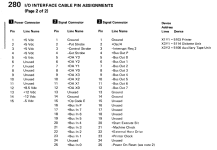voidstar78
Veteran Member
I'm working with an old system with a *pair* of DB25 connectors that aren't standard-anything (not RS-232). But, like RS-232, at least pin 1 is ground.
I have an 8-port scope, but it's getting "messy" trying to wire up that many individual BNC leads (mostly because of having to link up all the grounds). I get up to 4 or 5, then it's not much fun trying to monitor a few signals at a time (out of 48 other signals trying to see sychronous trends).
I suppose a pair of Arduino Mega's might be something to try for this? Not sure how fast that can read signals, but I think an individual Mega is 25+ GPIO pins. I think all the signals I'm looking at are 5v.
Does/did HP make anything for this? Something to just plug in a DB25 cable end, you designate which pin is ground (or go with pin 1 being ground), and from there it tells you any activity going on the rest of the pins? I'm not yet sure what resolution I'll need, that's part of the exploration.
I have an 8-port scope, but it's getting "messy" trying to wire up that many individual BNC leads (mostly because of having to link up all the grounds). I get up to 4 or 5, then it's not much fun trying to monitor a few signals at a time (out of 48 other signals trying to see sychronous trends).
I suppose a pair of Arduino Mega's might be something to try for this? Not sure how fast that can read signals, but I think an individual Mega is 25+ GPIO pins. I think all the signals I'm looking at are 5v.
Does/did HP make anything for this? Something to just plug in a DB25 cable end, you designate which pin is ground (or go with pin 1 being ground), and from there it tells you any activity going on the rest of the pins? I'm not yet sure what resolution I'll need, that's part of the exploration.



